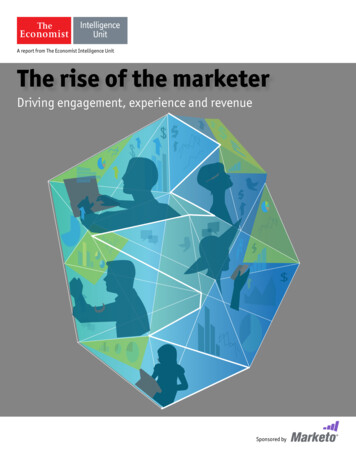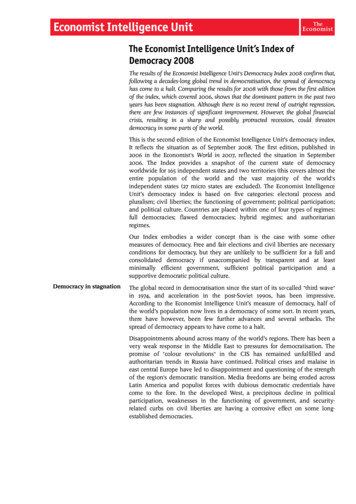
Transcription
Putting customers at the centre of the OEM supply chainA report from The Economist Intelligence UnitPutting customers at the centreof the OEM supply chain The Economist Intelligence Unit Limited 2019Sponsored by:A
Putting customers at the centre of the OEM supply chainContentsExecutive summary2Chapter 1: Introduction4Chapter 2: New technologies, new opportunities6Chapter 3: Data fuel the intelligent supply chain10Chapter 4: Mapping the journey13Chapter 5: Conclusion15Appendix: Survey results17 The Economist Intelligence Unit Limited 20191
Putting customers at the centre of the OEM supply chainExecutive summaryAround the world, original equipment manufacturers (OEMs) haveearmarked their supply-chain operations for digital transformation. Thereasons for this technological undertaking are clear: manufacturers are ona mission to improve customer service and build stronger, closer links withthe end-users of their products.A vital part of this picture is the emergence of so-called smart products, enabledby the Internet of Things (IoT). These products, which transmit data back toan OEM about their condition and usage, present an opportunity for OEMs tocommunicate directly with end-customers and offer them add-on products andnew services. At the same time, these smart products vastly extend the scope ofthe OEM supply chain.New technologies that support data-driven decision-making are key to addressingthe challenges posed by today’s extended supply chains. But how willing are OEMsto deploy them, and how prepared are they to identify and act on the valuableinsights new technologies will deliver? What are OEMs’ aspirations for intelligentsupply chains? And how can supply-chain transformation improve customerexperiences?These questions are the focus of this report by The Economist Intelligence Unit,which was sponsored by Microsoft. The research is based on a survey of more than250 senior business executives at OEMs in North America, Europe and Asia-Pacific.Key findings include: Ninety-nine percent of OEMs believe that the digital transformation oftheir supply chain is important to meeting their organisations’ strategic objectives. OEMs identify many emerging technologies as important to thecollection, analysis and use of supply-chain data. These include robotics(83%), IoT (71%), AI (63%) and blockchain (53%). According to the survey results, AI, IoT and blockchain are the leastwidely used technologies. Fewer than half (47%) of all respondents surveyedhave either widely used or used at least one for specific projects. However,early adopters of these emerging technologies more frequently identify theirorganisations as better performers in terms of financial success relative to thosethat are still piloting and evaluating or have yet to implement at all. This trendsuggests early adopters are already successfully integrating new technologiesinto the organisational strategy and deriving business value. The Economist Intelligence Unit Limited 20192
Putting customers at the centre of the OEM supply chain The stakeholders that OEMs most frequently partner with for collecting,analysing and using supply-chain data are B2B customers. Forty-ninepercent of respondents say they partner with them “a great deal”. Contact withdirect customers, however, lags behind, with 43% of OEMs saying they partnerwith downstream B2B2C customers a great deal. However, only half (51%) say that they use metrics relating to customeror stakeholder satisfaction to measure the success of digitisation intheir supply chain, suggesting significant room for improvement when itcomes to accurately identifying and meeting customer needs. OEMs are optimistic they can achieve meaningful business benefits fromsupply-chain transformation, including an improved ability to compete.Eighty-seven percent agree that five years from now it will be easier for theirorganisation to collect, analyse and use supply-chain data to meet their strategicobjectives. The Economist Intelligence Unit Limited 20193
Putting customers at the centre of the OEM supply chainCHAPTER 1:IntroductionThe supply chains of original equipment manufacturers (OEMs) have alwaysbeen complex and often unpredictable—but in the past, the supply chaintypically ended once a product was successfully delivered, preferably ontime, to a customer.In today’s hyper-connected world, OEMs are encountering new levels ofcomplexity. Not only must they manage the inbound delivery of the suppliesneeded to make their products and the outbound dispatch of finished goods tocustomers, but also they increasingly find themselves overseeing an extendedsupply chain that continues once smart, connected products are received andinstalled by end customers.Once in situ, these smart products use Internet of Things (IoT) technologies totransmit data back to the OEM about their condition and usage, alerting the OEMwhen they require maintenance work, or need a new part installing, or run low onvital consumables such as printing ink, detergent or sanding discs.The good news is that the added complexity of the extended supply chain alsobrings added business opportunity. The smarter the product, the more an OEMknows about how it is being used and what the customer might need from them,creating a closed feedback loop between OEM and customer.For forward-thinking OEMs, the extended supply chain is a chance to launch awhole range of often highly personalised add-on services to customers and, inreturn, gain vital new insights about their needs. It may even give rise to entirelynew business models: when an OEM has real, data-based insight into exactlyhow and when a product is being used, it can move away from selling productsto customers on the basis of a one-off, upfront purchase price, and charge themregular, pay-per-use fees. Rolls-Royce, for example, takes a monthly fee fromcustomers of its jet engines that is based on flying hours. Sellers of industrialmachinery such as Sandvik Coromant and Tetrapak are exploring the concept ofcharging customers for parts machined and containers filled, respectively.OEMs agree that new technologies hold the key to better customer insight andservice, fuelled by data collected at every stage in this extended supply chain. Ina new survey of more than 250 senior business executives at OEMs worldwide,conducted by The Economist Intelligence Unit and sponsored by Microsoft,executives are almost unanimous in their agreement that digital transformation oftheir organisation’s supply chain is important to meeting its strategic objectives andcompeting in the marketplace. Nearly all respondents (99%) think it is important,with more than six out of ten (62%) regarding it as very important.The hope is that a more intelligent extended supply chain, powered by data fromboth internal sources and smart products, when combined with advanced analyticcapabilities, will create new opportunities for competitive differentiation. The Economist Intelligence Unit Limited 20194
Putting customers at the centre of the OEM supply chainBut in order to take advantage of these new opportunities, OEMs must cast theirnet much wider, collecting data from many different sources, in unprecedentedvolumes, in order to gain new insights into product performance, customer usageand business outcomes, as well as end-to-end supply-chain performance.In order to do so, they will need to continue to invest in cloud, in order to access thealmost limitless computing power and storage capabilities that it offers. They willneed to use global cloud infrastructure to collect, store and process huge volumesof IoT data gathered from their own assets and systems and from smart productsalready installed with customers.They will also start to explore how newer, emerging technologies such as artificialintelligence (AI) and blockchain might help to introduce intelligence, traceabilityand increased security to their data infrastructure and analytics capabilities inorder to get the most from the extended supply chain.“Big data is a massiveopportunity for supplychain managementbecause it has thepotential to deliver realtransparency and totallychange our view of supplychain performance.”Daniel Helmig, group head ofquality and operations, ABB“Senior supply-chain professionals have typically been accustomed to workingwith a fairly limited set of data to drive their decisions—but that’s all changednow,” says Daniel Helmig, group head of quality and operations at Swiss-Swedishindustrial group ABB.“Big data is a massive opportunity for supply-chain management because it hasthe potential to deliver real transparency and totally change our view of supplychain performance. Our thinking can be guided by a clearer view of reality, ratherthan our best guesses of what we think is happening in the supply chain, based onan incomplete set of rather fragmented information,” he says.“But being able to take advantage of the huge volumes of data available to us—and these are growing every day—demands a mindshift among supply-chainprofessionals, based on using new levels of visibility to respond to issues quicklyand decisively. Supply-chain transformation is not about digital technology itself,but about the insights and actions that digital technology can enable.” The Economist Intelligence Unit Limited 20195
Putting customers at the centre of the OEM supply chainCHAPTER 2:New technologies, new opportunitiesAt China-based ICT provider Huawei Technologies, a more digitised, extendedsupply chain plays a key role in the company’s strategy to put the needs ofcustomers at the heart of everything it does, according to Lorenzo Fornaroli, seniordirector of global logistics and supply chain.“Our high-level objectives are ones that we share with other companies: we wantto be responsive to customer demand and deliver the best customer experiencepossible,” he says.But, he concedes, the company has a “distinct advantage” over many other OEMS,“because as an ICT company, we have the internal resources needed to identifynew technologies early and deploy them effectively. Skills and experience withthese technologies are readily available in-house,” he says.The bedrock of the enhanced customer experience that Huawei targets, he adds,is operational efficiency. “Digitisation delivers operational efficiency by reducingmanual work, increasing automation and speeding up access to information tomake decisions faster,” he says. “It’s about achieving a higher level of intelligenceacross the end-to-end supply chain.”That view is echoed by survey respondents. When asked about their organisations’top strategic objectives, improving operational efficiency is the number oneresponse among OEMs surveyed, cited by one in three (33%) respondents.But at the same time, they’re looking beyond day-to-day activities, citing increasingmarket share (28%), developing new products and services (26%), both goals withthe customer at their heart, as well as improving financial performance (25%).And beyond that, ensuring that the business strategy reflects new data-drivenopportunities and entering new markets are each cited by 19% of respondents.Figure 1Organisations’ top strategic objectives(% of respondents)Improve operational efficiency33Increase market share28Develop new products and solutions26Improve financial performance25Ensure business strategy reflects data-driven opportunities19Enter new markets19Raise brand awareness17Better understand and engage end usersIncrease effectiveness of external partnerships1513Source: Economist Intelligence Unit survey, 2018. The Economist Intelligence Unit Limited 20196
Putting customers at the centre of the OEM supply chainFigure 2New technologies that enable the effective collection, analysis and use ofsupply-chain data(% of respondents who replied “somewhat” or “a great ce: Economist Intelligence Unit survey, 2018.They see great promise in several new technologies in helping them reach thesegoals. The technologies that they consider most important to the effectivecollection, analysis and use of supply-chain data are cloud (97%), robotics (83%),IoT (71%), AI (63%) and blockchain (53%).The emphasis on cloud makes sense: it is, after all, an OEM’s best chance of beingable to gather data at unprecedented scale and low cost and put it to use. It’s alsoan opportunity to experiment with new approaches such as high-performancecomputing for analysis and simulation. Few, if any, have ever had the on-premiseinfrastructure or skills available, most commonly associated in the past withuniversities and research laboratories, to use such advanced techniques ongrowing volumes of IoT data from supply-chain assets and smart products in thefield.But there is still much work to do. When asked which of these technologies arealready widely used across their companies, respondents put cloud in front (61%).Lagging by some distance are robotics (18%) and IoT (16%), while blockchain andAI have yet to see widespread usage, cited by just 5% and 4% of respondents,respectively.The widespread usage of cloud is notable given that, in just the past few years,manufacturers have largely overcome concerns about its adoption. This suggeststhat many now consider it a foundational component of their organisation’s onwarddigital strategy. This is hardly surprising, given the vast geographic footprint ofmany supply chains and the impact that IoT technologies are having on them interms of the need to collect and store huge volumes of data, often in real time.IoT, in particular, via real-time data collection, offers a potential bridge betweenthe cloud and the advanced algorithmic decision-making available from AI.Indeed, IoT may potentially fuel the analytics capabilities of AI by collecting andaggregating the data most useful to businesses, across every stage of the extendedsupply chain.Blockchain, however, remains in the early stages of commercialisation. Use ofdistributed ledger technology will likely increase in coming years as more OEMsexperiment with and scale up different blockchain-based solutions like smartcontracts or inventory tracking.Importantly, OEMs that have already taken bets on these technologies believethey are already reaping the benefits of competitive advantage. The Economist Intelligence Unit Limited 20197
Putting customers at the centre of the OEM supply chainAccording to the survey results, AI, IoT or blockchain are the least widely usedtechnologies. Fewer than half (47%) of all respondents surveyed have eitherwidely used or used at least one for specific projects. However, early adopters ofthese emerging technologies more frequently identify their organisations as betterperformers in terms of financial success, relative to those that are still piloting andevaluating or have yet to implement at all. This trend suggests early adopters arealready successfully integrating new technologies into the organisational strategyand deriving business value.Take cloud adoption, for example: among respondents at organisations that havealready implemented cloud, 58% describe their organisation as being moderatelyor significantly ahead of their industry peers in terms of financial performance,compared with 50% at organisations that don’t use cloud.Five key supply-chain technologies1. CloudCloud has played an increasingly important role insupply-chain transformation in recent years, thanks toits facilitation of hosted platforms where supply-chaindata can be easily shared and analysed at scale and atlow cost. This change has liberated a great deal of usefuldata previously locked away on in-house, back-officesystems at individual companies. It is also the logicaldestination for collecting, storing and processing thedata that stream from smart products, giving clues intotheir condition and the ways that they are being used bycustomers.2. RoboticsIn factory and warehouse environments, robotics oftenperform tasks such as product assembly and orderpicking, typically faster and with a greater degree ofaccuracy than humans. Modern robotics integrate wellwith other supply-chain technologies, which enable themto sense their surroundings, work co-operatively withpeople and more rapidly adapt to new tasks.3. Internet of Things (IoT)The “Industry 4.0” trend has led many warehouse andplant-floor assets to bristle with sensors, offering factorymanagers a real-time view of inventory levels andproduction processes. Machine-based sensors can help The Economist Intelligence Unit Limited 2019predict equipment failures, and telemetry systems onconnected vehicles enable them and the goods they carryto be tracked at every stage of the delivery journey. Thisis also the foundational technology underpinning smartproducts, enabling them to communicate directly withoriginal equipment manufacturers (OEMs) and creating adirect link between an OEM and its customer.4. Artificial intelligence (AI)AI is changing supply-chain activities by aiding decisionmaking and process automation in areas such as demandforecasting, production planning and order fulfilment.Complex AI algorithms can analyse large quantities ofdata, learn from the results and use this knowledge tocontinuously refine and improve business strategies,operations and processes. With smart products, it isused in approaches such as predictive maintenance, toforecast when a product might require servicing, basedon the data it transmits back to the OEM.5. BlockchainThis technology helps make supply chains moretransparent and efficient. It provides multiple partiesin an end-to-end supply chain (such as parts suppliers,OEMs and logistics providers) with a shared andimmutable record of the delivery of goods, as parts andthen products make their journey to the end-user.8
Putting customers at the centre of the OEM supply chainIn terms of IoT, among respondents that have already implemented this technology,67% describe their organisation as being ahead in terms of financial performance,versus 48% at those that have yet to adopt it.With AI, 63% of respondents at organisations that have adopted the technologydescribe these organisations as being ahead of peers in terms of financialperformance, compared with 53% at organisations that haven’t adopted thetechnology. This strongly suggests that early adopters of technologies that drivegreater supply-chain visibility and lay the groundwork for an extended supplychain are already reaping the financial rewards. The Economist Intelligence Unit Limited 20199
Putting customers at the centre of the OEM supply chainCHAPTER 3:Data fuel the intelligent supply chainCollecting data from existing and new technologies is a step in the rightdirection. But true transformation of the extended supply chain can onlyhappen by using data-driven insights to improve customer service, cost andagility.“In the past, a great deal of supply-chain decision-making was based on intuition,because data wasn’t available,” says Sheri Henck, vice-president of global supplychain, distribution and logistics at Medtronic, a US-based manufacturer of medicalequipment and devices.“Today, there’s plenty of data available, but there’s also a recognition that skills andcompetencies for supply-chain leaders and their teams need to change if we areto make the most of data and use it to make data-driven recommendations anddecisions,” she adds.That’s a view echoed by analysts at strategy firm McKinsey in a mid-2017 report,Digital supply chains—do you have the skills to run them?. Its authors write: “Todrive digital supply-chain transformations, supply-chain leadership must combinetraditional functional and leadership capabilities with new technical skills thatspan data, algorithms, and technology. And they need to understand more thanjust what these innovations are: they must also understand whether – and how–they create real value for the businesses they are supposed to support.”“Today, there’s plenty ofdata available, but there’salso a recognition thatskills and competenciesfor supply-chain leadersand their teams needto change if we are tomake the most of dataand use it to make datadriven recommendationsand decisions.”Sheri Henck, vice-president of global supplychain, distribution and logistics, MedtronicAt present, they continue, significant skills gaps can be detected in the supplychain teams at most organisations—and recruitment alone won’t tackle theproblem. “In the short term, automation and digitisation will create more rolesfor data scientists, analytics engineers, and IT and big-data specialists, who bringnew knowledge to the supply-chain organisation. But to produce lasting results,this new talent will need training in supply-chain management, or support from‘translators’ who blend functional and digital knowledge.”Figure 3Wide range of data collected, used and analysed(% of respondents who replied they were "very successful" at collecting, using and analysing these types of data)51Supplier data48End-user dataCustomer data47Internal manufacturing data4741Logistics dataContract manufacturing data34Source: Economist Intelligence Unit survey, 2018. The Economist Intelligence Unit Limited 201910
Putting customers at the centre of the OEM supply chainAdditionally, OEMs need to be sure they have the “right” data when makingdecisions. Indeed, it is one challenge to make sure data are available but entirelyanother to ensure it is the type of data most useful for business decision-making.When asked which types of supply-chain data they consider most helpful in meetingtheir organisation’s strategic objectives, customer data comes out on top, cited by52% of respondents, followed by supplier data (47%), internal manufacturing data(45%) and logistics data (43%).The survey reveals that a wide range of data are considered valuable in supply-chaintransformation. When it comes to collecting, using and analysing the data verysuccessfully, supplier data comes out on top, according to 51% of OEMs. Next onthe list come end-user data (48%), and customer data and internal manufacturingdata (both 47%). Logistics data (41%) and contract manufacturing data (34%) arealso cited by survey respondents.Despite the challenges involved in collecting such a wide variety of data, most OEMshave prepared for, initiated and begun to benefit from the data in a number ofways. Forty-nine percent have digitised information from supply-chain operationsa great deal and made it available across their organisation, while almost the sameproportion (51%) have identified supply-chain data of business value. Meanwhile,50% of respondents have used supply-chain data a great deal to better managetheir customer service operations.Other steps taken include: Assessing and preparing for data-related risks (44%); establishing policies and procedures to gather supply-chain data (47%); identifying strategic insights from the data (51%); using the data to better manage factory operations (54%); and using the data to inform new products and services (41%).Third-party data from supply-chain partners are an important part of this picture,too. The OEM model, after all, often involves business-to-business (B2B) customerswho are responsible for reselling and distributing products to downstream endconsumers, or B2B2C customers.The effort to partner with supply-chain stakeholders is already under way amongOEMs, but they anticipate much work ahead. Compared with five years ago, 75%partner with stakeholders more frequently. Looking ahead, this collaboration looksset to continue, with 89% expecting to partner with supply-chain stakeholdersmore frequently in the next five years.The stakeholders that OEMs most frequently partner with for collecting, analysingand using supply-chain data are B2B customers. Forty-nine percent of respondentssay they partner with them “a great deal”. Contact with direct customers, however,lags behind, with 43% of OEMs saying they partner with downstream B2B2Ccustomers a great deal. Still, that’s ahead of the companies that deliver finished The Economist Intelligence Unit Limited 201911
Putting customers at the centre of the OEM supply chainFigure 4The importance of stakeholder partnerships(% of respondents who partner with other supply chain stakeholders a great deal to collect, analyse and use supply chain data)49B2B customers48Materials and parts suppliers43Downstream B2B2C customers41Outbound logistics providers38Contract manufacturersInbound logistics providers37Source: Economist Intelligence Unit survey, 2018.products to customers (outbound logistics partners) and those deliveringmaterials, parts and components to OEMs (inbound logistics partners), with 41%and 37% of OEMs, respectively, saying they partner with these companies onsupply-chain data “a great deal”.However, only 51% say that they use metrics relating to customer and/orstakeholder satisfaction to measure the success of digitisation in their supply chain,compared with 62% using improved profitability. This suggests that links with endcustomers are still not as strong, or offering as much insight, as OEMs would like. The Economist Intelligence Unit Limited 201912
Putting customers at the centre of the OEM supply chainCHAPTER 4:Mapping the journeyThere is still much work to be done and, for many supply-chain professionals,significant barriers to more efficient analysis and use of data persist.Respondents do not underestimate the challenges ahead. Top of the list of barriersis cost (cited by 32%), followed by the difficulty of integrating new technologieswith legacy systems (24%), changing customer needs (23%), an overwhelmingamount of data (23%) and security concerns (22%).For most OEMs—and most businesses in general—the journey to the intelligent supplychain will likely be based on incremental improvements. Maturity levels in overalldigitisation or adoption of emerging technologies may be low for many businessestoday, but companies are already building foundations for real benefits over time.For example, a 2017 cross-industry study from McKinsey suggests that the averagesupply chain has a digitisation level of just 43%.1 (Of course The EconomistIntelligence Unit study just looked at OEM manufacturers). But the same studypoints to potentially huge wins from supply-chain transformation, suggesting that,on average, companies that aggressively digitise their supply chains might expectto boost annual growth of earnings before interest and taxes by 3.2% and annualrevenue growth by 2.3%.Survey respondents are optimistic that they can achieve meaningful businessbenefits from supply-chain transformation. Five years from now, 34% expectsupply-chain data to have improved operational efficiency at their company,while 32% believe it will improve supplier management. Respondents alsoanticipate improvements in cyber-security, employee productivity and customerengagement (each cited by 28% of respondents).1 ntionOn this last issue of customer engagement, Mr Helmig points to a trend he hasseen in recent years. ABB may be in the business of selling large-scale industrialproducts—from high-voltage power lines to electric propulsion systems for ships—but its customers have increasingly high expectations for delivery. “They expecttransparency,” he says. “They expect to be able to have real-time insight regardingFigure 5Top strategic challenges(% of respondents selecting their top three)32Cost24Difficulty integrating new technologies with legacy systemsChanging customer needs23An overwhelming amount of data2323Regulations and complianceSecurity concerns22Source: Economist Intelligence Unit survey, 2018. The Economist Intelligence Unit Limited 201913
Putting customers at the centre of the OEM supply chainthe location of their delivery and an estimated time of arrival—and we agree theyshould have those things, too. It’s something we’re working on right now, using arange of analytics.”And once smart products are installed with customers, they can be a rich source ofdemand data, alerting the OEM to customer needs when it comes to maintenanceservices, for example, or consumables. In other words, this could be the start ofan ongoing conversation between an OEM and the customer around a product’smaintenance, replenishment and eventual replacement.It can also open up entirely new business models: a smart product that constantlytransmits data on how it is being used is a prime target for being offered on apay-per-use basis, rather than merely for a one-time, upfront purchase fee. Aspreviously mentioned, these charges are likely to focus on business outcomes:flying hours, parts machined, bottles filled and so on.Finally, an in-depth understanding of how a product is used by the customer offersopportunity for individualisation, particularly in the case of high-value products,which might be tailored or customised based on individual end-customer needs.In the survey, for example, 49% of respondents say their organisation is “somewhatprepared” for new business models such as renting versus selling, while 37% saythey are “very prepared”. This is clearly a goal towards which OEMs want to move.That said, the effort involved should not be underestimated; the focus on customeroutcomes and customised products introduces new complexities, in the formof services tailored to the individual needs of customers and a greater number ofproduct variants. OEMs will potentially need to tweak their field service provisionand inventory strategies in order to be able to fulfil their promises to every customer.“For example, an executiveteam needs to knowthe company can meetcustomer demand,without spendingmoney unnecessarily onstoring excess inventory,but instead using it todevelop and ship newproducts. So for supplychain professionals, Isee my role as being atrusted informant to thebusiness, who helps
a mission to improve customer service and build stronger, closer links with the end-users of their products. A vital part of this picture is the emergence of so-called smart products, enabled by the Internet of Things (IoT). These products, which transmit data back to an OEM about thei











